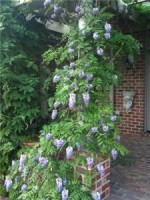 Scrambling over a wall or up a pergola, attracting birds, or adding color and fragrance vines can be an important part of an American cottage garden. Vines not only add color but also can be used to create atmosphere and cover up eyesores. Most vines are fast growing and can quickly climb over vertical surface so that everything behind it is hidden. Likewise, they can be used to hide utility areas, children’s’ play equipment, or the neighbors yard. Most of all, vines can add a feeling of nostalgia to the garden and that is probably its most significant contribution.
Scrambling over a wall or up a pergola, attracting birds, or adding color and fragrance vines can be an important part of an American cottage garden. Vines not only add color but also can be used to create atmosphere and cover up eyesores. Most vines are fast growing and can quickly climb over vertical surface so that everything behind it is hidden. Likewise, they can be used to hide utility areas, children’s’ play equipment, or the neighbors yard. Most of all, vines can add a feeling of nostalgia to the garden and that is probably its most significant contribution.
Here are six native woody vines that will make a beautiful addition to a cottage garden.
American Wisteria (Wisteria frutescens)
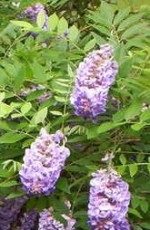 This is not the wisteria most frequently seen consuming whole houses. It is far more well behaved and is native to from Maryland to Florida and west to Texas and Arkansas. The racemes of lilac-purple flowers are shorter than those of its rambunctious Asian cousins, but they appear in spring and continue to throughout the summer. The vines grow up to 40’ long and can quickly cover a pergola with abundant attractive foliage.
This is not the wisteria most frequently seen consuming whole houses. It is far more well behaved and is native to from Maryland to Florida and west to Texas and Arkansas. The racemes of lilac-purple flowers are shorter than those of its rambunctious Asian cousins, but they appear in spring and continue to throughout the summer. The vines grow up to 40’ long and can quickly cover a pergola with abundant attractive foliage.
Light: Full sun
Soil: Average, well-drained
Hardiness: Zones 6-9
Carolina Jasmine (Gelsemium sempervirens)
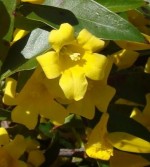 Growing to 20 feet, this evergreen vine blooms in April and May with delicately fragrant 5-lobed trumpet shaped yellow flowers. Not a true jasmine, this vine is native to the southeastern US and is the state flower of South Carolina.
Growing to 20 feet, this evergreen vine blooms in April and May with delicately fragrant 5-lobed trumpet shaped yellow flowers. Not a true jasmine, this vine is native to the southeastern US and is the state flower of South Carolina.
Light: Full sun to part shade
Soil: Humus rich, moist, well-drained
Hardiness: Zones 7-11
Cross Vine (Bignonia capreolata)
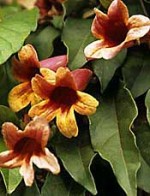 So-named for the + seen in cross section of the stem, cross vine is a rampant grower reaching 30-40’. The flowers are orange-red usually with magenta blotches inside, and are borne in clusters of –5 blooms in April and May. Native from Maryland to Florida, west to Louisiana, Missouri, and Illinois.
So-named for the + seen in cross section of the stem, cross vine is a rampant grower reaching 30-40’. The flowers are orange-red usually with magenta blotches inside, and are borne in clusters of –5 blooms in April and May. Native from Maryland to Florida, west to Louisiana, Missouri, and Illinois.
Light: Sun to partial shade
Soil: Average, moist
Hardiness: Zones 5-9
Coral Honey Suckle (Lonicera sempervirens)
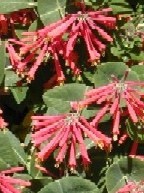 Native from Massachusetts to Florida, west to Texas and Nebraska, this hardy twining vine is evergreen in its southern range. It grow 10-20 feet long and bears clusters of two inch long scentless tubular orange-red flowers in April and May. Do not confuse this native species with a similar Asian one that has become invasive along roadsides and elsewhere.
Native from Massachusetts to Florida, west to Texas and Nebraska, this hardy twining vine is evergreen in its southern range. It grow 10-20 feet long and bears clusters of two inch long scentless tubular orange-red flowers in April and May. Do not confuse this native species with a similar Asian one that has become invasive along roadsides and elsewhere.
Light: Full sun to part shade
Soil: Rich, moist, well-drained
Hardiness: Zones 4-9
Virginia Bower (Clematis virginiana)
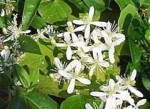 Most of our native vines bloom primarily in the spring but this one blooms from midsummer to fall with masses of small white flowers and are followed by attractive seed heads entwined with delicate gray curly threads. Native from Quibec to Georgia and west to Louisiana, Kansas, and Manitoba, this semi-evergreen clematis is a strong climber and grows to 18 feet.
Most of our native vines bloom primarily in the spring but this one blooms from midsummer to fall with masses of small white flowers and are followed by attractive seed heads entwined with delicate gray curly threads. Native from Quibec to Georgia and west to Louisiana, Kansas, and Manitoba, this semi-evergreen clematis is a strong climber and grows to 18 feet.
Light: Full sun to light shade
Soil: Rich, moist, well-drained
Zones: 3-9
Trumpet Vine (Campsis radicans)
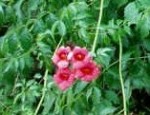 A native from Pennsylvania to Florida, west to Texas, trumpet vine is a rampet climber that can reach up to 40’ tall. It clings by means of aerial roots, a fact reflected by its specific name radicans. Trusses of three inch long orange-red funnel-shaped flowers open in July to September and are followed by pods 3-5 inches long. Hummingbirds love trumpet vine flowers.
A native from Pennsylvania to Florida, west to Texas, trumpet vine is a rampet climber that can reach up to 40’ tall. It clings by means of aerial roots, a fact reflected by its specific name radicans. Trusses of three inch long orange-red funnel-shaped flowers open in July to September and are followed by pods 3-5 inches long. Hummingbirds love trumpet vine flowers.
Light: Full to part sun
Soil: Average, well-drained
Hardiness: Zones 5-11
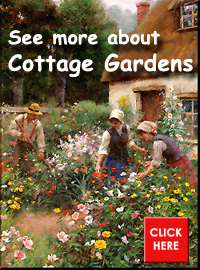 All of these vines are native to eastern US but many can be grown in other areas of the country. Most of the vines listed have been grown and bred to produce cultivars that are more showy. Some cultivars are heirlooms but many are not so if you want to focus on heirlooms the safe thing to do is stick to the species. Information of the status of various cultivars is spotty and it is difficult to determine which ones have been grown for more than 50 years and which ones have not. Only those with at least 50 years in the trade are actually heirlooms.
All of these vines are native to eastern US but many can be grown in other areas of the country. Most of the vines listed have been grown and bred to produce cultivars that are more showy. Some cultivars are heirlooms but many are not so if you want to focus on heirlooms the safe thing to do is stick to the species. Information of the status of various cultivars is spotty and it is difficult to determine which ones have been grown for more than 50 years and which ones have not. Only those with at least 50 years in the trade are actually heirlooms.